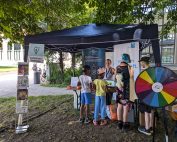Fundamentals of Energy Conversion Processes
A DFG Cluster of Excellence
News
TUM portrays e-conversion researcher Helge Stein
Meet this versatile battery expert in the latest "NewIn" episode.
e-conversion was at the Klima.Dult 2024
A market of ideas to make cities more sustainable.
Plasmonic Energy: On the Track of Electrons
Scientists from LMU and Rice University provide a new framework for the holistic description of plasmon-molecule interactions and electron transitions at their interfaces.
Events

Schulferien bei e-conversion
Workshops zu Solarenergie bei den außerschulischen Lernorten MUC-Labs.

TUM-Entdeckerinnen
e-conversion bietet Ferien-Workshops für Mädchen am Forschungscampus Garching an.

Landesgartenschau in Kirchheim
e-conversion is presenting itself in the pavilion of the Bavarian State Office for the Environment

e-conversion Conference 2024 in Venice
Please register for our Cluster Conference together with CeNS in September 2024.
Highlights
Recent Publications
The Critical Role of Anharmonic Lattice Dynamics for Macroscopic Properties of the Visible Light Absorbing Nitride Semiconductor CuTaN2 Journal Article
In: Advanced Energy Materials, vol. 14, no. 19, pp. 2303059, 2024, ISSN: 1614-6832.
Autonomous battery optimisation by deploying distributed experiments and simulations Journal Article
In: ChemRxiv, 2024.
Attention towards chemistry agnostic and explainable battery lifetime prediction Journal Article
In: npj Computational Materials, vol. 10, no. 1, pp. 100, 2024, ISSN: 2057-3960.













